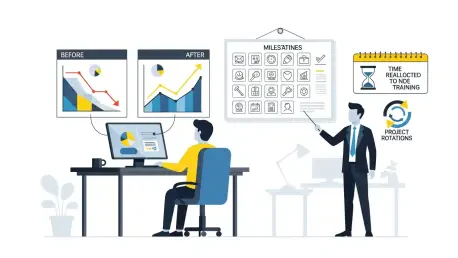Employee unease around artificial intelligence has reached a volume that drowns out even the most impressive pilot results, and unless that fear is addressed head‑on before scaling programs in 2026, transformation efforts will slow, fragment, or quietly fail in the middle. This year laid pipes: data cleanup, vendor due diligence, and early copilots; next year will test whether people actually want to use what’s been built. Surveys show most U.S. workers remain anxious about AI’s impact, with only a minority seeing personal upside, and that sentiment silently taxes collaboration, learning velocity, and productivity. The HR agenda therefore shifts from technical readiness to human readiness: explain what AI will do, teach how to use it safely, and tie visible outcomes to career mobility. The organizations that thrive will treat trust as an operating requirement, not soft garnish.
Lead With Transparency And Early Communication
The first move is clarity. Employees rarely fear the technology itself; they fear the unknown—hidden criteria in performance reviews, opaque data use, or a surprise tool swap that reshapes their week without input. Leaders who stay “front and center” reduce those shadows. Explain what AI will and will not decide, with real timelines and accountable owners. Share why a particular model or vendor was chosen and how data is protected, including the audit paths for human oversight. When intent and impact are discussed early and often, resistance softens into questions, and questions become invitations to co‑design. That cadence should be predictable: monthly forums, skip‑level Q&As, and micro‑updates in the flow of work, not just big‑stage announcements.
Transparency also means acknowledging trade‑offs. A copilot that drafts customer emails may raise concerns about tone or bias; say so, show the test results, and state the controls. When frontline teams hear leaders narrate uncertainty and mitigation in plain language, confidence grows because the organization sounds like it has a plan, not a pitch. HR can model this by publishing clear policies on acceptable use, data retention, and human‑in‑the‑loop checkpoints, then enforcing them consistently. That governance is not a brake; it is a seatbelt that encourages people to drive. Moreover, setting these expectations before rollout closes the rumor mill and gives managers talking points that align with legal and security teams, reinforcing one source of truth across the enterprise.
Make Learning Hands-On And Reframe Risk
Training must move beyond slide decks to muscle memory. Roadshows, bootcamps, and role‑based labs help employees practice prompting, evaluate outputs, and understand when to escalate to a human. Retailers have shown traction by inviting associates to experiment with tools like My Assistant during facilitated sessions, co‑creating use cases that simplify tasks they know best—planogram adjustments, meeting summaries, or knowledge lookups. That tactile experience reframes “disruption” as relief: fewer clicks, faster drafts, better coaching conversations. HR’s role is to curate these moments, pair novices with early adopters, and certify managers on how to set boundaries, measure gains, and document exceptions. The message becomes pragmatic: use AI to enhance judgment, not bypass it.
Narrative matters just as much. Many workers aren’t worried about AI per se; they’re worried about being left behind by colleagues who become AI‑enabled faster. Framing the risk this way redirects energy into upskilling rather than defensiveness. Offer tiered learning paths tied to roles and pay progression, and spotlight employees who used AI to hit stretch goals, not those who simply automated busywork. Performance systems can help here: with AI‑assisted goal‑setting, managers propose richer objectives that elevate scope—cross‑functional analysis, customer insights, scenario planning—making growth concrete. By linking completion of AI fluency milestones to mobility and recognition, the organization turns education into opportunity, and fear into forward motion.
Turn Use Cases Into Career Mobility And Trustworthy Governance
Visible wins accelerate acceptance when they improve daily work and point to a better job tomorrow. Early use cases should be embedded where friction lives: scheduling, ticket triage, policy queries, and draft creation. Each deployment needs clear guardrails—human review thresholds, escalation paths, and feedback loops that retire poor prompts and promote strong patterns. Publish the before‑and‑after metrics so teams see time returned to higher‑value tasks, then route that time into development: shadowing, certifications, or project rotations. When AI frees capacity and leadership reinvests it in people, the technology feels like a ladder, not a trapdoor. That perception shift drives adoption more reliably than any slogan.
Governance, often treated as a compliance chore, becomes the backbone of trust when it is visible and participatory. Establish a cross‑functional council that includes frontline representatives, not just legal, security, and data science. Give the council authority to approve use cases, sunset tools, and publish incident reviews in plain English. Adopt consistent taxonomies for risk, and require human‑in‑the‑loop for decisions that alter pay, scheduling, or performance ratings. Communicate how models are monitored for drift and bias, and invite employees to report anomalies without fear of reprisal. By pairing tactical wins with guardrails that respect dignity and agency, HR aligns the human story with the technical one, reducing fear while raising standards.
A Roadmap Built On Sentiment And Proof
The next phase did not ask for bigger models; it demanded better stewardship. The playbook centered on four moves: communicate early and plainly, teach by doing, frame risk around skills rather than jobs, and showcase use cases that advance both output and careers, all under governance that employees could see and influence. HR stood ready to lead both people change and policy design, making sentiment a metric alongside accuracy and cost. With that approach, adoption was more than a rollout; it was a relationship. Organizations that executed this plan entered 2026 with employees who felt informed, skilled, and optimistic, and with AI programs that earned the trust they intended to keep.









